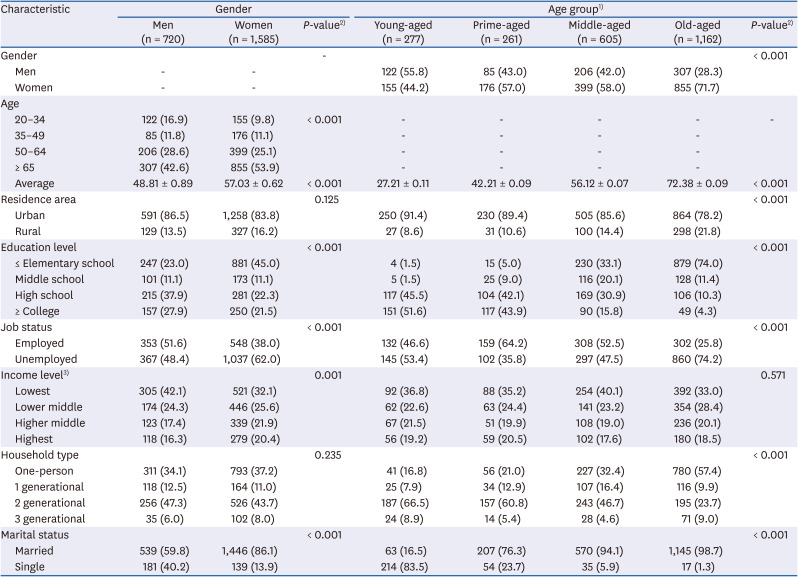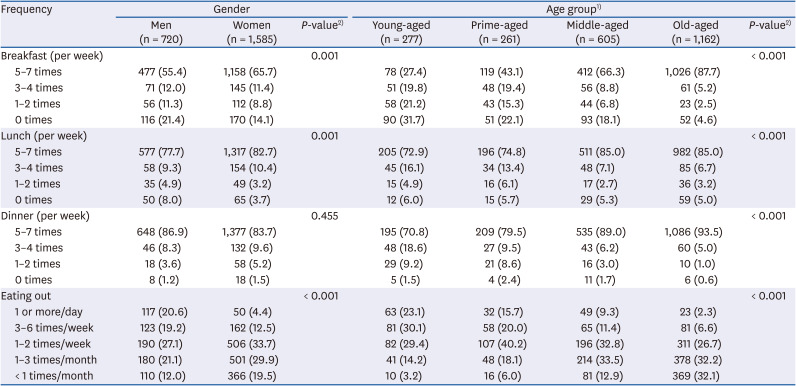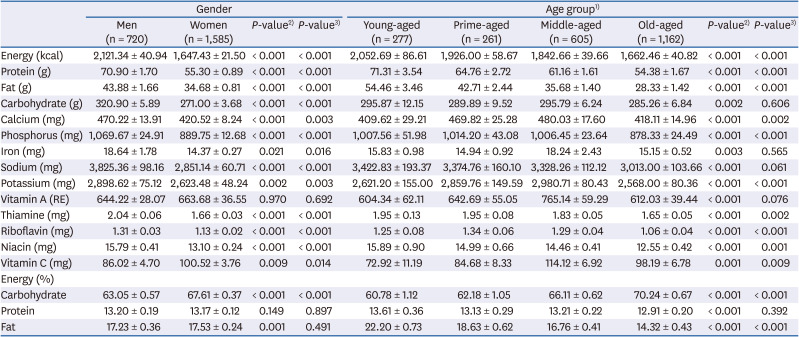1. Kerner S, Chou C, Warmind M. Commensality: from everyday food to feast. London: Bloomsbury Publishing;2015.
2. Kim HW. Single-person households and broadcasting trends change. Media Educ. 2015; 5:152–171.
5. Kang Y, Kang S, Kim KJ, Ko H, Shin J, Song YM. The association between family mealtime and depression in elderly Koreans. Korean J Fam Med. 2018; 39:340–346. PMID:
30376700.



6. Lee KI, Hwang YJ, Ban HJ, Lim SJ, Jin HJ, Lee HS. Impact of the growth of single-person households on the food market and policy tasks. Report No. R762. Naju: Korea Rural Economic Institute;2015.
7. Song EG, Yoon YS, Yang YJ, Lee ES, Lee JH, Lee JY, Park WJ, Park SY. Factors associated with eating alone in Korean adults, findings from the Sixth Korea National Health and Nutrition Examination Survey 2014. Korean J Fam Pract. 2017; 7:698–706.

8. Kimura Y, Wada T, Okumiya K, Ishimoto Y, Fukutomi E, Kasahara Y, Chen W, Sakamoto R, Fujisawa M, Otsuka K, Matsubayashi K. Eating alone among community-dwelling Japanese elderly: association with depression and food diversity. J Nutr Health Aging. 2012; 16:728–731. PMID:
23076516.


9. Tani Y, Sasaki Y, Haseda M, Kondo K, Kondo N. Eating alone and depression in older men and women by cohabitation status: the JAGES longitudinal survey. Age Ageing. 2015; 44:1019–1026. PMID:
26504120.

10. Wang X, Shen W, Wang C, Zhang X, Xiao Y, He F, Zhai Y, Li F, Shang X, Lin J. Association between eating alone and depressive symptom in elders: a cross-sectional study. BMC Geriatr. 2016; 16:19. PMID:
26774626.



11. Kwon AR, Yoon YS, Min KP, Lee YK, Jeon JH. Eating alone and metabolic syndrome, a population-based Korean National Health and Nutrition Examination Survey 2013–2014. Obes Res Clin Pract. 2018; 12:146–157. PMID:
29066025.


12. Song SY, Jeong YH. Association between eating alone and metabolic syndrome: a structural equation modeling approach. J Korean Diet Assoc. 2019; 25:142–155.
13. de Castro JM, de Castro ES. Spontaneous meal patterns of humans: influence of the presence of other people. Am J Clin Nutr. 1989; 50:237–247. PMID:
2756911.


14. Locher JL, Robinson CO, Roth DL, Ritchie CS, Burgio KL. The effect of the presence of others on caloric intake in homebound older adults. J Gerontol A Biol Sci Med Sci. 2005; 60:1475–1478. PMID:
16339337.



15. Hetherington MM, Anderson AS, Norton GN, Newson L. Situational effects on meal intake: a comparison of eating alone and eating with others. Physiol Behav. 2006; 88:498–505. PMID:
16757007.


16. Park YA. Dietary behavior and nutrient intake of high school students in Seoul: focused on students who eat alone [dissertation]. Seoul: Hanyang University;2011.
17. Bae YJ. Evaluation of nutritional status in Korean adolescents according to eating breakfast together as a family: based on the 2013~2015 Korea National Health and Nutrition Examination Survey. Korean J Food Nutr. 2017; 30:1210–1221.
18. Lee YM, Cho WK, Oh YJ. Comparison of eating behavior between commensality and solo-eating of university students by BMI. Korean J Community Nutr. 2012; 17:280–289.

19. Kim HK, Chung J. Associations of the eating alone behavior with nutrient intake, obesity and metabolic syndrome in middle-aged adults based on the 2013 ~ 2017 Korean National Health and Nutrition Examination Survey. J Nutr Health. 2019; 52:435–448.

20. Lee EJ, Lee KR. Comparison of solo eating perception and dietary behaviors according to gender in the Seoul and Gyonggi-do regions. J Korean Soc Food Cult. 2018; 33:531–542.
21. Lee Y, Oh YJ, Cho W, Jo PK. Differences in solo eating perceptions and dietary behaviors of university students by gender. J Korean Diet Assoc. 2015; 21:57–71.

22. Tani Y, Kondo N, Takagi D, Saito M, Hikichi H, Ojima T, Kondo K. Combined effects of eating alone and living alone on unhealthy dietary behaviors, obesity and underweight in older Japanese adults: results of the JAGES. Appetite. 2015; 95:1–8. PMID:
26116391.


23. Jo PK, Oh YJ. Comparison of dietary behavior of eating alone in single households by status of workers and age. Korean J Community Nutr. 2019; 24:408–421.

24. Park SH, Lee KS, Park HY. Dietary carbohydrate intake is associated with cardiovascular disease risk in Korean: analysis of the third Korea National Health and Nutrition Examination Survey (KNHANES III). Int J Cardiol. 2010; 139:234–240. PMID:
19013653.


25. Ministry of Health and Welfare (KR). The Korean Nutrition Society. Dietary reference intakes for Koreans 2015. Seoul: The Korean Nutrition Society;2015.
26. Guthrie HA, Scheer JC. Validity of a dietary score for assessing nutrient adequacy. J Am Diet Assoc. 1981; 78:240–245. PMID:
7217578.

27. Madden JP, Goodman SJ, Guthrie HA. Validity of the 24-hr. recall. Analysis of data obtained from elderly subjects. J Am Diet Assoc. 1976; 68:143–147. PMID:
1245715.

28. Kant AK, Block G, Schatzkin A, Ziegler RG, Nestle M. Dietary diversity in the US population, NHANES II, 1976-1980. J Am Diet Assoc. 1991; 91:1526–1531. PMID:
1960344.

29. Yang SJ. Nutritional risk and its contributing factors in the low-income elderly in urban areas. J Korean Acad Community Health Nurs. 2005; 16:392–403.
30. Ministry of Health and Welfare (KR). The Korean Nutrition Society. Korea health statistics 2017: Korea National Health and Nutrition Examination Survey (KNHANES VII-2). Sejong: Ministry of Health and Welfare;2019.
31. Lee JW. Effects of frequent eating-out and breakfast skipping on body mass index and nutrients intake of working male adults: analysis of 2001 Korea National Health and Nutrition Survey data. Korean J Community Nutr. 2009; 14:789–797.
32. Lee KA, Jeong BY, Moon SK, Kim IS, Soichiro N. Comparisons of Korean adults' eating habits, food preferences, and nutrient intake by generation. Korean J Nutr. 2006; 9:494–504.
33. Min C, Noh H, Kang YS, Sim HJ, Baik HW, Song WO, Yoon J, Park YH, Joung H. Skipping breakfast is associated with diet quality and metabolic syndrome risk factors of adults. Nutr Res Pract. 2011; 5:455–463. PMID:
22125684.



34. Lachat C, Nago E, Verstraeten R, Roberfroid D, Van Camp J, Kolsteren P. Eating out of home and its association with dietary intake: a systematic review of the evidence. Obes Rev. 2012; 13:329–346. PMID:
22106948.


35. An HK. A study on the recognition and practice for reducing sodium intake of one-person households [dissertation]. Seoul: Chung-Ang University;2015.
36. Choi BB. Recognition and consumption of meal alone and processed food according to major of college students. Korean J Food Nutr. 2016; 29:911–922.

37. Yates L, Warde A. Eating together and eating alone: meal arrangements in British households. Br J Sociol. 2017; 68:97–118. PMID:
27859004.


38. Choi J, Park H, Song K, Kwon S, Lee Y. Menu evaluation of meal boxes sold in Korean convenience stores. J Food Nutr Res. 2018; 6:18–25.












 PDF
PDF Citation
Citation Print
Print



 XML Download
XML Download